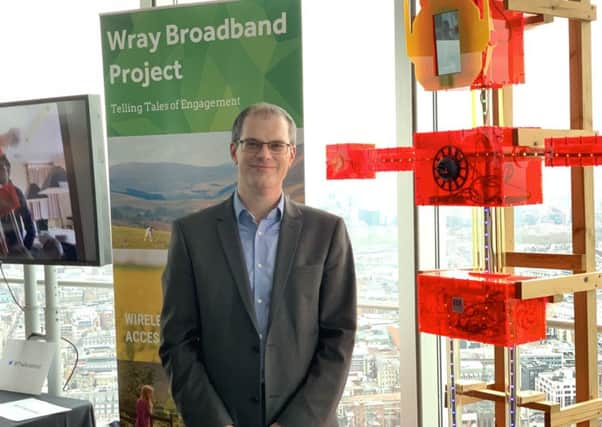Lancaster’s rural broadband initiative celebrated at Digital Economy event


The Wray Broadband project, delivered by computing experts at Lancaster University, saw the village of Wray become the first UK village to get wireless broadband in 2003. The village also became the first in the country to get high-speed broadband in 2010 through the second phase of the project. This involved the use of fibre and an expansion of the network to include remote houses and farms by the villagers themselves, helped by the university.
The pioneering project, which contributed to Lancaster University receiving a Queen’s Anniversary Prize in 2005, was selected by the Engineering and Physical Sciences Research Council (EPSRC) as a success story to feature as part of an event celebrating ten-years of investment in the Digital Economy, which was held at the iconic BT Tower in London in March.
Advertisement
Hide AdAdvertisement
Hide AdWray is famous for its annual ‘Scarecrow Festival’ and as a way of illustrating the benefits of delivering rural broadband in the village the researchers, through an EPSRC ‘Telling Tales of Engagement’ award, created an interactive ‘digital scarecrow’. The digital scarecrow, which includes tablet computer screens and other mobile computing devices such as Raspberry Pi and Arduinos, enables people to control what it does, like play music and blow bubbles.
The digital scarecrow, which was first taken to the Wray Scarecrow Festival in 2013, also made an appearance at the BT Tower showcase event, which was attended by academics, funders and representatives of industry.
The Wray Broadband project followed on from an initiative that involved University experts delivering Internet connectivity to rural schools around Cumbria and Lancashire. Frustrated by poor Internet connectivity, the community of Wray asked the University’s computing network experts if they could deliver broadband to the whole community – in addition to their primary school.
Nick Race, Professor of Networked Systems at Lancaster University’s School of Computing and Communications, who led the Wray Broadband Project, said: “We were approached by the Wray community in 2003 to help them address a key challenge for the village: the lack of available access to the Internet. At that time the only access available was via slow, often unreliable, dial-up services.”
Advertisement
Hide AdAdvertisement
Hide Ad“Our research into wireless mesh networks enabled us to work with the villagers and deploy a series of ‘mesh’ boxes which linked together and provided the whole community with Internet access. Key to the success of the project has been the relationship established with the Wray community – enabling them to help themselves and expand the network further with support from university researchers.”
To showcase the possibilities of rural broadband, a special cricket match was streamed live over the Internet using the Wray wireless network. Known as the ‘Twicket’ match, the event received national and international media attention and support over Twitter from celebrities such as Stephen Fry.
The Wray Broadband project also led to the village mesh being connected with fibre, which delivered superior data speeds. The community aspect of this work and research fed into the development of B4RN (Broadband for the Rural North), which now delivers broadband connectivity throughout the North West and has been adopted by other rural areas throughout the country. It does this by enabling people to build their own connections to the Internet themselves.
“The project is a great example of how researchers and communities can work together, and it is fantastic to see the continued impact of this work and its growth regionally and nationally through B4RN,” said Prof Race.
Advertisement
Hide AdAdvertisement
Hide AdChris Conder MBE, one of the co-founders of B4RN and Project Manager of the Wray Broadband Project, said: “I got involved with the Wray project as a means of getting a broadband connection for myself, my husbands’ farm business and my kids. We then took everything we had learned, and built a network in the nearby village of Wennington, with the help of the University. The Wennington project enabled me to run my own IT business from home and for my family to stay in touch. When my neighbours’ trees grew too tall to get a stable wireless connection from my farm we experimented connecting them with fibre, and this whole experience - and feedback from it - led Professor Barry Forde MBE, Lindsey Annison, Monica Lee and I to found B4RN, which has now connected over 5,000 properties with gigabit symmetrical fibre broadband and continues to connect rural communities across the UK.”